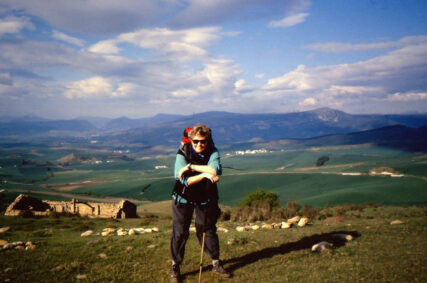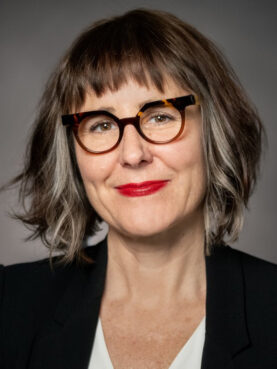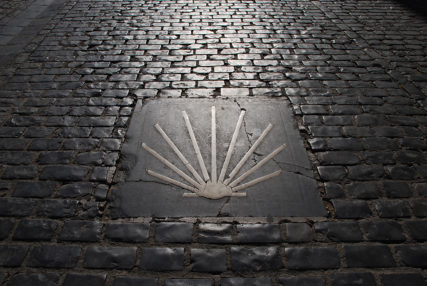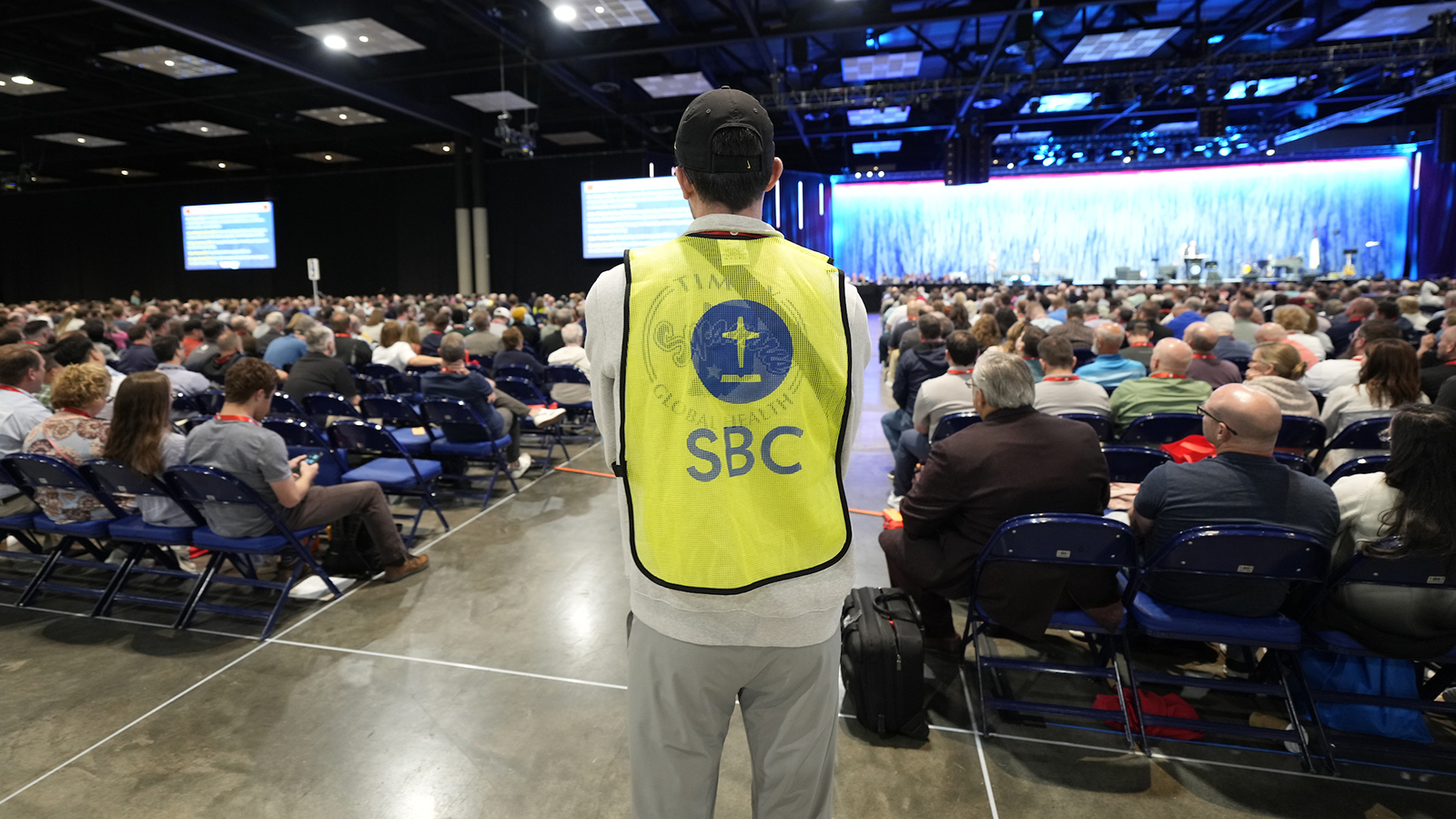The Camino, once a Catholic pilgrimage, increasingly draws the spiritual but not religious
(RNS) — In her early 30s, Rachael Sanborn found herself in a bad relationship and dreaming of an escape to the Camino de Santiago in Spain, a pilgrimage her father had undertaken that had profoundly changed his life.
Sanborn, a rebel and adventurer by nature (she dropped out of college to meditate in India for a year), quit her job, gave up health insurance and pooled her savings to take two months to walk the Camino. By the third day of her walk, she promised herself she’d return every year. Nine months later, she was back, guiding her first group of eight pilgrims.
A decade later, now 45 and residing in the Bay Area, she leads grief walks and walking meditations on the Camino with the travel company she founded, Red Monkey Walking Travel. The red monkey is a nod to Hanuman, the Hindu god of joyful service. Raised Tibetan Buddhist, Christian and Jewish, Sanborn considers herself all three. She believes everyone can find a way for the Camino to work for their religion.
“We have had everyone from devout Catholics to atheist Chinese nationals,” said Sanborn. “The Camino for the last 1,000 years was always open to everyone from all religions. Some of my first Camino friends walked from Iran. Iran! And stopped in or outside every locked church and read Rumi poems.”
Rachael Sanborn. (Courtesy photo)
Sanborn represents a growing trend of non-Catholic — even non-Christian — pilgrims venturing on the Camino. In 2023, nearly half a million people walked the Camino de Santiago in Spain. About 40 percent of those walked for purely religious reasons, according to statistics released by the pilgrims’ office. While it’s traditionally a Catholic pilgrimage, ending at the shrine of the apostle James in the Cathedral of Santiago de Compostela, secular pilgrims today embark on the Camino for all kinds of motivations beyond religion: health, grief, transition, cultural exploration, history and adventure.
Sharon Hewitt of St. John’s in Newfoundland, Canada, walked part of the Camino in the fall of 2016 with two friends. Her motivation was to spend time with friends and take a “purposeful” vacation. Hewitt doesn’t consider herself religious but recognized a type of devotion in the rituals and challenges of the eight days of walking.
“I didn’t do it for religious reasons, but there is overlap,” says Hewitt. “A lot about religion is discipline, just like the Camino. After a hard night, you still get up and go on.”
This synthesis of religious and secular motivations is profound for people like Nancy Mead, president of The Friends of the Anglican Centre in Santiago de Compostela, an ecumenical religious organization. Mead, an Episcopalian who lives in Rhode Island, says there are as many reasons why people walk the Camino as there are people who walk it. While the Camino is a religious experience for her, she has also learned life lessons along the way that apply to everybody, religious or not. She’s walked seven different routes on the Camino and has to remind herself each time to lighten her load; makeup and extra clothes are just added weight on the journey.

Nancy Mead poses on the Camino de Santiago in Spain. (Courtesy photo)
The number of “spiritual but not religious” pilgrims on the Camino has increased over the past two decades as the demographic has grown and with the emergence of “secular spirituality.” Jacqui Frost, whose research at Purdue includes health and wellbeing among the nonreligious, says researchers are increasingly using the language of spirituality to talk about secular experiences of feeling connected to something greater than yourself — something that, she says, often happens in nature.
“We have started to secularize a lot of what used to be religious rituals,” said Frost. “Think about meditation, yoga or even atheist churches. A lot of people are interested in rituals and finding meaning in these collective events.”
As this growing spiritual but not religious group borrows religious rituals and beliefs, there is a question of how to do so without appropriating them. Many of the reasons nonreligious people go on the Camino are similar to why religious people go. In a 2019 study in the “Sociology of Religion” journal, researchers examined atheists’ versus religious pilgrims’ motivations to walk the Santiago way and found overwhelming overlap across motivations; most were looking to connect to nature and one’s deeper self. The only two measures that differed were community and religious motivations, which were both higher for religious pilgrims.
RELATED: What the Camino shows us about travel and mortality

Liz Bucar. (Photo © Liz Linder Photography)
Religious ethics expert and author of the forthcoming book “The Religion Factor: How Restoring Religion to Our Spirituality Makes It More Meaningful, Responsible, and Effective,” Liz Bucar, says the growing number of spiritual but not religious pilgrims represents a need for meaning-making, even when you’ve rejected religion. But she doesn’t think it’s as easy as just dropping the religion part and isn’t so sure you can still get the same benefits without it.
“If you want to get the real meat out of pilgrimage, you have to engage with the religion of it,” says Bucar. “Spirituality is what they are calling the pieces of religion that they like. Religion is part of the secret sauce.”
After all, Bucar says, pilgrimage is spiritual tourism. She describes the Camino today as a “curated, socially constructed experience with institutions involved.” Bucar used to lead college students on the Camino but came to believe the trip fed into an idea that you can access this spiritual connectedness or transcendence through participating in a temporary experience. She says the Camino falls into this category, which her new book is about, of these spiritual hacks and shortcuts people take when they “don’t want to do religion.”
Bucar required the students to write an application essay for the class, and most cited the desire to have a transformative experience as their reasoning for wanting to walk the Camino. “They’re looking for a quick fix, an experience that will change their life,” she said.
She’s not opposed to taking students again. But she’d do it differently. Instead of focusing on the inward journey, she’d encourage her students to study the historical context of the routes and the contentious parts of history that the official Spanish tour guides might be leaving out. After all, St. James is also known as Santiago Matamoros, the “Moor-slayer.” You won’t hear about the story of Matamoros helping Charlemagne murder Muslims from a tour guide. She would put the construction of historical narratives front and center.
“I’d make it less fun for them and less of an ‘experience.’ It’s much more valuable to have these experiences be uncomfortable and disorienting,” said Bucar. “You have to engage with the religion of it.”

A shell symbol of the Camino de Santiago along the pilgrimage route in Logroño, Spain. (Photo by Juanje 2712/Creative Commons)
For Sanborn, Christianity will always be at the heart of the Camino — even for those bringing a different religion or no religion to their pilgrimage — though she agrees with Bucar that Christianity on the Camino has not always been beautiful.
“I think it’s important to honor the Christianity of the Camino, and appreciate the traditions and amazing art and architecture of the Camino. But the Camino also walks over both where over 80 people were taken from their mountain homes and the city where they were burnt at the stake. So I think it’s important to see the best and worst of religion,” said Sanborn. “Each time I step into a church or cathedral on a hot day, it feels impossible to not be awed.”
However, Sanborn resists the idea that non-Catholic pilgrims — “sometimes people call them tourist-pilgrims” — are unable to experience what the Camino has to offer.
“Everyone I have ever met along the Camino is getting more than they expected, so it’s probably best not to judge,” she said. “The Camino is just so special in ways I don’t pretend to understand, which is part of the great mystery of life. It’s magic.”
RELATED: People (and dogs) we meet on the Camino
Source link


